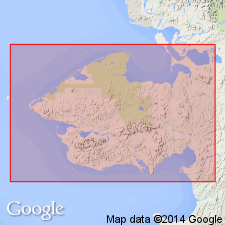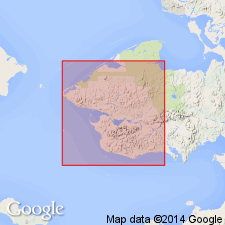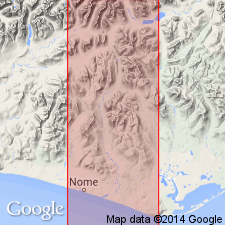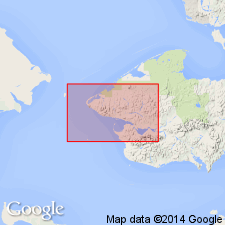
- Usage in publication:
-
- Kigluaik series*
- Modifications:
-
- Named
- Dominant lithology:
-
- Limestone
- Schist
- AAPG geologic province:
-
- Seward Peninsula province
- Alaska West-Central region
Summary:
First found in heart of Kigluaik Mountains, Seward Peninsula, AK; later identified at other localities including Bendeleben Mountains. Is highly crystalline limestone interbedded with gray mica schists and some amphibole schists. Limestone of unit is usually massive, pure, generally white but sometimes bluish. Is intruded by granites. Is more metamorphosed than overlying Kuzitrin series (new). Map legend gives age as Paleozoic or older.
Source: GNU records (USGS DDS-6; Menlo GNULEX).

- Usage in publication:
-
- Kigluaik group*
- Modifications:
-
- Redescribed
- Age modified
- Dominant lithology:
-
- Limestone
- Schist
- Gneiss
- AAPG geologic province:
-
- Seward Peninsula province
- Alaska West-Central region
Summary:
Kigluaik series of Brooks and others (1901) redescribed as Kigluaik group. Is group of highly crystalline rocks consisting of limestones, schists, and gneisses. Is considered to be either Silurian or pre-Silurian age based on stratigraphic relation to Nome group.
Source: GNU records (USGS DDS-6; Menlo GNULEX).

- Usage in publication:
-
- Kigluaik group*
- Modifications:
-
- Revised
- AAPG geologic province:
-
- Seward Peninsula province
- Alaska West-Central region
Summary:
In region of Mount Osborn, Kigluaik group is divided into basal gneiss, overlying limestone, and upper formation, herein named Tigaraha schist. Age of group is considered to be Paleozoic (possibly in part pre-Paleozoic).
Source: GNU records (USGS DDS-6; Menlo GNULEX).

- Usage in publication:
-
- Kigluaik Group*
- Modifications:
-
- Age modified
- Geochronologic dating
- AAPG geologic province:
-
- Seward Peninsula province
- Alaska West-Central region
Summary:
Group is divided (in Teller 2x4 deg quad) into (ascending); lower gneiss (1500 ft thick), marble (500 ft thick), Tigaraha Schist (which includes 360 ft of quartz-biotite schist and 550 ft of marble), and orthogneiss (which locally includes small areas of undifferentiated metamorphic rocks). Age is considered Precambrian on basis of geologic evidence and two radiometric ages of 750 MA (C.E. Hedge, written commun., 1969) using whole-rock Rb-Sr method of analysis on sample of orthogneiss from southeast corner of Teller quad and sample from granitic dike cutting lower gneiss on west face of Mount Osborn.
Source: GNU records (USGS DDS-6; Menlo GNULEX).
For more information, please contact Nancy Stamm, Geologic Names Committee Secretary.
Asterisk (*) indicates published by U.S. Geological Survey authors.
"No current usage" (†) implies that a name has been abandoned or has fallen into disuse. Former usage and, if known, replacement name given in parentheses ( ).
Slash (/) indicates name conflicts with nomenclatural guidelines (CSN, 1933; ACSN, 1961, 1970; NACSN, 1983, 2005, 2021). May be explained within brackets ([ ]).

